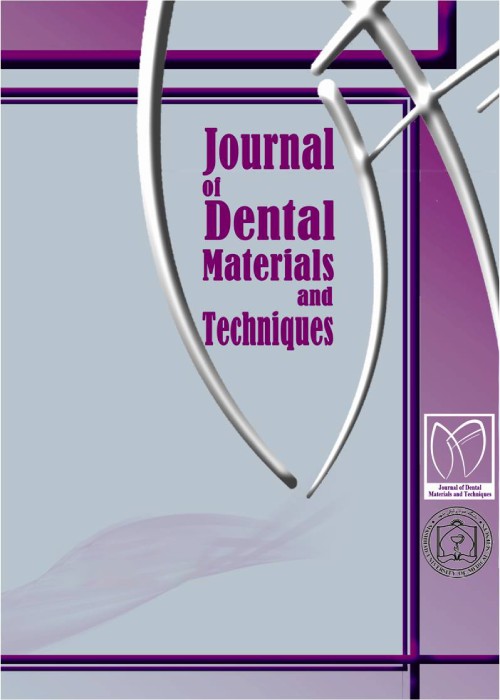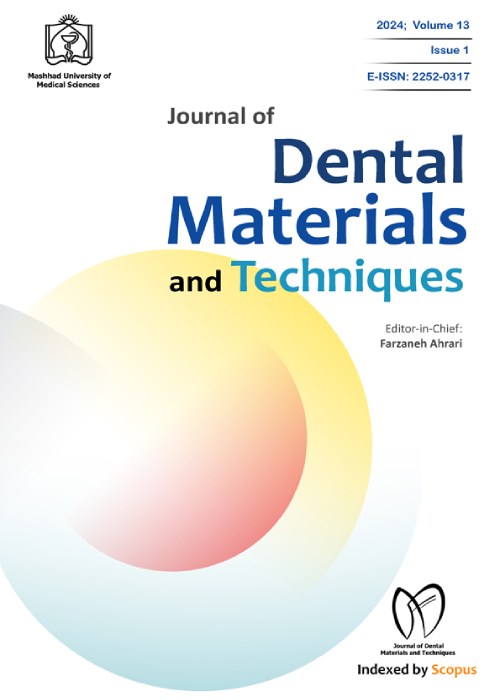فهرست مطالب

Journal of Dental Materials and Techniques
Volume:12 Issue: 4, Autumn 2023
- تاریخ انتشار: 1402/09/10
- تعداد عناوین: 8
-
-
Pages 160-167ObjectiveThe present study evaluated the pulp tissue response following direct pulp capping (DPC) with several materials in dogs’ teeth.MethodsThis study was performed on four doges with 64 mature healthy premolars and molars. The teeth randomly received the following materials: platelet-rich plasma (PRP), propolis, MTA, and glass-ionomer cement (GIC, negative control group). Afterwards, the teeth were restored with light cure GIC. Half of the animals were sacrificed after seven and half after 30 days. Histologic samples were prepared (n=8 per material/interval), and the levels of inflammation, and fibrous and calcified tissue formation were compared between the groups and intervals.ResultsAfter seven days, inflammation and calcified tissue levels were comparable among the groups (P ). The MTA group showed significantly more fibrous tissue formation than the GIC samples (P<0.05). After 30 days, propolis and MTA showed significantly lower inflammation than GIC (P<0.05). PRP and MTA groups showed significantly higher fibrous tissue formation than the GIC group (P<0.05). Moreover, GIC showed the lowest calcification level among the groups, and PRP had lower calcification than MTA (P<0.05). Inflammation levels of the experimental groups decreased after 30 days, but the change was not significant (P>0.05). Fibrous tissue formation in the MTA and propolis groups decreased significantly after 30 days (P<0.05). Calcification levels of the experimental groups increased significantly over time (P<0.05).ConclusionsThe findings suggest that propolis might be a favorable substitute for MTA in DPC procedures, as it produced comparable results to MTA in reducing inflammation and enhancing calcification.Keywords: Animal model, Dental pulp capping, Histology, MTA, Propolis, Platelet-rich plasma
-
Pages 168-174ObjectiveThis study aimed to assess canal morphology of maxillary first molars by analyzing cone beam computed tomography (CBCT) images.MethodsA total of 324 maxillary first molars were collected from the Turkish population and scanned using the in vitro CBCT method. The number of roots and canals, root canal configuration, canal shape, the presence of a C-shaped canal, apical delta, and lateral canal, as well as the distance between radiographic and anatomic apices were examined.ResultsThe majority of the samples (97.9%) had 3 separate roots; while the remaining teeth had two or four roots (1.5% and 0.6% respectively). CBCT results showed 2, 3, 4, and 5 root canals in 0.3%, 47.9%, 50.3% and 1.5% of the teeth, respectively. All distobuccal (DB) and palatal (P) roots had one canal. The mesiobuccal (MB) roots frequently showed a second mesiobuccal canal (MB2). The most common canal morphology in the MB roots was type I (33.1%), followed by type II and type III (29.0% and 9.8%, respectively). The P and DB roots commonly showed a type I canal configuration. C-shaped canals were rare. The mean distances between radiographic and anatomic apices in MB, DB, and P roots were 0.77 ± 0.45, 1.68 ± 0.9 and 0.91 ± 0.46 mm, respectively.ConclusionsThe MB roots of maxillary first molars showed greater variations in their canal anatomy than other roots. These anatomical differences, potentially attributable to ethnic variations, should be considered when performing surgical or nonsurgical root canal treatments on maxillary molars.Keywords: Cone beam computed tomography, Endodontic, Lateral canal, Maxillary molar, Root canal, Tooth root
-
Pages 175-179ObjectiveThis study aimed to compare the surface microhardness of a nanohybrid and a microhybrid resin composite light-cured at two different distances.MethodsA total of 40 disc specimens were prepared for this in vitro experiment; 20 from a nanohybrid composite resin (Filtek P60; 3M ESPE) and 20 from a microhybrid composite resin (Filtek Z250; 3M ESPE). Each group was divided into two equal subgroups (n=10), based on the distance between the light-curing device and the composite surface (either 2 or 4 mm). After 24 hours of curing, the teeth underwent the microhardness test to determine the Vickers hardness number (VHN) at the surface. The data were subjected to statistical analysis using a two-way analysis of variance (ANOVA) at the significance level of P<0.05.ResultsThe nanohybrid resin composite showed higher microhardness values than the microhybrid resin at both 2 mm and 4 mm distances, although the difference between the two groups was only significant at the distance of 4 mm (P = 0.017). No significant difference was observed in the nanohybrid composite resin between the two curing distances (P = 0.151). However, the hardness of the microhybrid composite decreased significantly with increasing the curing distance from 2 to 4 mm (P = 0.015).ConclusionsThis study reveals that light-curing distance significantly affects the microhardness of microhybrid composite resin. The nanohybrid composite showed comparable hardness up to the distance of 4 mm, indicating its suitability to be used in situations where a close curing distance cannot be achieved.Keywords: Composite resins, Curing lights, Hardness test, Microhybrid composite, Nanohybrid composite, Restorative treatment
-
Pages 180-185Objective
Oral and dental problems are important issues in patients suffering from hematologic malignancies. This study aimed to assess the efficacy of supragingival irrigation with chlorhexidine in improving the oral health status of patients with hematologic malignancies.
MethodsThis randomized, single-blind, controlled clinical trial, included 32 patients suffering from blood dyscrasia and hospitalized in Imam-Reza Hospital, Mashhad, Iran. Participants were randomly allocated to intervention and control groups. The control subjects received routine dental care by cleaning their teeth daily with sterilized gauze soaked in normal saline. For the intervention group, supra-gingival irrigation with chlorhexidine was performed in addition to routine dental care. The Debris Index Simplified (DI-S) part of the Oral hygiene index-simplified (OHI-S) index was recorded in all patients at baseline (T0), one (T1), two (T2), and three (T3) weeks later. The World Health Organization (WHO) scale was used to assess oral mucositis.
ResultsDI-S decreased significantly in the intervention group (P<0.001), and increased significantly in the control group (P=0.04) over the experiment. The study groups had comparable DI-S values at baseline (T0; P=0.48). However, DI-S scores were significantly lower in the experimental than in the control group at T1, T2, and T3 time points (P=0.002, P<0.001, and P<0.001, respectively). Oral mucositis was observed in only five patients in the control group.
ConclusionsSupra-gingival irrigation with chlorhexidine can improve oral hygiene during chemotherapy and may be used by patients and oral care providers in hospital settings.
Keywords: Chlorhexidine, Dental plaque, Gingivitis, Hematologic malignancies, irrigation, Oral hygiene -
Pages 186-190Objective
This study examined the impact of a blue covarine whitening mouthwash on enhancing the color of stained composite resin specimens and teeth.
MethodsThis in vitro study involved a total of 72 specimens including 36 human incisors and 36 disks prepared from a resin composite. The specimens in each group were randomly distributed to three subgroups (n=12) according to the applied mouthwash: Listerine, iWhite and a control group. Control specimens were maintained in distilled water throughout the study. The remaining specimens were immersed in a coffee solution for two weeks, then treated with either Listerine (containing hydrogen peroxide) or iWhite (containing blue covarine) mouthwashes. The immersion lasted for four minutes daily over 56 days. Color assessment was performed by a spectrophotometer at baseline (T1), post-staining (T2), and post-mouthwash immersion (T3) and color change (ΔE) between stages was calculated.
ResultsSignificant discoloration was observed after immersion in coffee solution in the experimental groups as compared to the control (P<0.05). The color change between baseline (T1) and after immersion in mouthwashes (T3) was not significantly different between the two experimental groups on tooth samples (P=0.12). However, ΔE (T1-T3) was significantly lower in iWhite (ΔE=2.27) than the Listerine mouthwash (ΔE=4.99) on composite specimens (P<0.001).
ConclusionsBoth hydrogen peroxide- and blue covarine-containing mouthwashes showed comparable effects in restoring tooth discolorations, although the color changes were detectable after treatment (ΔE > 3.3). The mouthwash containing blue covarine (iWhite) restored the original color of composite resin specimens more successfully than the mouthwash containing hydrogen peroxide (Listerine).
Keywords: Bleaching, Blue covarine, color, Composite Resin, Mouthwash, Tooth discoloration -
Pages 191-197ObjectiveThis study aimed to assess the shape and size of the nasopalatine canal (NPC) using cone beam computed tomography (CBCT) in Iranian patients.Materials and MethodsThis cross-sectional descriptive study investigated 285 CBCT scans of the anterior maxilla, obtained from patients in Rafsanjan, Iran. The shape of the nasopalatine canal was categorized as banana (twisted), funnel (diverging towards the oral or nasal cavity), cylindrical, and hourglass. The length and diameter of the canal were measured using multiplanar images. Labial bone thickness was recorded at two points: A at the incisive foramen and B at the foramen of Stenson. Kruskal-Wallis and chi-square tests were used for analysis at P<0.05.ResultsThe hourglass shape was the dominant canal model in the sample. The mean canal length and the mesiodistal and labiopalatal diameter (at incisive foramen) were 11.17 ± 2.5 mm, 3.6 ± 1.2 mm, and 3.4 ± 1.2 mm, respectively. Moreover, the mean bone thickness at points A and B were 6 ± 1.4 and 8 ± 4.4 mm. A significant difference was found among different canal shapes concerning bone thickness at point B (P=0.01) and labiopalatal width of the canal (P<0.001). There was a direct and significant relationship between the patient’s age and the mesiodistal and labiopalatal widths of the NPC (P=0.001 and P=0.015, respectively).ConclusionConcerning the age-related and race-related variations in nasopalatine canal morphology, CBCT scans are recommended for accurate evaluation before implant placement or orthodontic retraction in the anterior maxilla.Keywords: Bone thickness, Cone beam computed tomography, Dental implants, Incisive foramen, Nasopalatine Canal
-
Pages 198-203ObjectiveThe access cavity preparation technique might influence the fracture resistance of endodontically treated teeth. This study evaluated the impact of preserving the enamel-dentin bridge on fracture resistance of endodontically treated mandibular molars.MethodsA total of 42 mandibular molars were randomly divided into three groups according to the access cavity design: Traditional endodontic access cavity (TEC), truss endodontic access cavity (TREC), and control (CON) (n=14). The teeth in each group were divided into two equal subgroups (with and without thermocycling). The control group was stored in saline over the experiment, whereas class II mesio-occlusal access cavities were prepared in the two experimental groups. In the TEC design, a conventional access cavity was prepared. In the TREC design, the occlusal enamel and dentin between the mesial and distal root canal orifices were not removed. Endodontic treatment, and composite resin restoration were performed similarly in the experimental groups. The teeth were subjected to fracture resistance testing in an Instron machine and the load at fracture was compared among the groups.ResultsThe CON group had significantly superior fracture resistance than the two experimental groups (P<0.05), which showed comparable fracture load values at both conditions (P>0.05). Thermal cycling reduced fracture resistance in both TEC and TREC groups (P<0.05), but had no significant effect in the control group (P=0.624).ConclusionsConsidering the similar fracture resistance of the TEC and TREC groups, the study suggested that preserving the enamel-dentin bridge does not enhance fracture resistance in endodontically treated teeth with mesio-occlusal cavities.Keywords: conservative treatment, Dental Pulp Cavity, Dentin, fracture resistance, root canal obturation, Root Canal Therapy
-
Pages 204-208Objective
In this case report, we employed an admix material to record the neutral zone in a patient presenting with a palatal fistula and an atrophic mandibular ridge.
Case report:
In this case report, we present a 67-year-old edentulous female with a history of oropharyngeal carcinoma affecting the soft palate. A circular palatal fistula, measuring approximately 8mm×8mm, was identified at the junction of the hard and soft palate. The mandibular residual ridge displayed significant atrophy. The neutral zone was recorded using admix material, comprising three parts by weight of impression compound and seven parts by weight of tracing compound. The fabricated dentures yielded favorable outcomes in terms of denture stability, and patient comfort. The patient reported the absence of nasal regurgitation and a notable improvement in speech production due to the obturator prosthesis.
ConclusionThe neutral zone impression technique with admix impression material provided successful results in constructing both a mandibular complete denture and a maxillary denture with an obturator. The retention and stability of the complete denture were desirable and the patient was satisfied with the outcome.
Keywords: Alveolar ridge, Atrophy, complete denture, dental prosthesis, fistula, obturator


